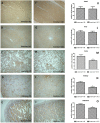Vitamin D3 Reduces Tissue Damage and Oxidative Stress Caused by Exhaustive Exercise
- PMID: 26941574
- PMCID: PMC4764782
- DOI: 10.7150/ijms.13746
Vitamin D3 Reduces Tissue Damage and Oxidative Stress Caused by Exhaustive Exercise
Abstract
Exhaustive exercise results in inflammation and oxidative stress, which can damage tissue. Previous studies have shown that vitamin D has both anti-inflammatory and antiperoxidative activity. Therefore, we aimed to test if vitamin D could reduce the damage caused by exhaustive exercise. Rats were randomized to one of four groups: control, vitamin D, exercise, and vitamin D+exercise. Exercised rats received an intravenous injection of vitamin D (1 ng/mL) or normal saline after exhaustive exercise. Blood pressure, heart rate, and blood samples were collected for biochemical testing. Histological examination and immunohistochemical (IHC) analyses were performed on lungs and kidneys after the animals were sacrificed. In comparison to the exercise group, blood markers of skeletal muscle damage, creatine kinase and lactate dehydrogenase, were significantly (P < 0.05) lower in the vitamin D+exercise group. The exercise group also had more severe tissue injury scores in the lungs (average of 2.4 ± 0.71) and kidneys (average of 3.3 ± 0.6) than the vitamin D-treated exercise group did (1.08 ± 0.57 and 1.16 ± 0.55). IHC staining showed that vitamin D reduced the oxidative product 4-Hydroxynonenal in exercised animals from 20.6% to 13.8% in the lungs and from 29.4% to 16.7% in the kidneys. In summary, postexercise intravenous injection of vitamin D can reduce the peroxidation induced by exhaustive exercise and ameliorate tissue damage, particularly in the kidneys and lungs.
Keywords: 4-Hydroxynonenal; Calcitriol; lipid peroxidation..
Conflict of interest statement
Competing interests: The authors have declared that no competing interest exists.
Figures



Similar articles
-
Vitamin D3 supplementation modulates inflammatory responses from the muscle damage induced by high-intensity exercise in SD rats.Cytokine. 2013 Jul;63(1):27-35. doi: 10.1016/j.cyto.2013.03.018. Epub 2013 May 10. Cytokine. 2013. PMID: 23669253
-
Protective effects of L-arginine supplementation against exhaustive exercise-induced oxidative stress in young rat tissues.Chin J Physiol. 2009 Oct 31;52(5):306-15. doi: 10.4077/cjp.2009.amh068. Chin J Physiol. 2009. PMID: 20034235
-
Cyanoside chloride and chromocarbe diethylamine are more effective than vitamin C against exercise-induced oxidative stress.Pharmacol Toxicol. 2001 Nov;89(5):255-8. doi: 10.1034/j.1600-0773.2001.d01-156.x. Pharmacol Toxicol. 2001. PMID: 11881979
-
Free radicals in exhaustive physical exercise: mechanism of production, and protection by antioxidants.IUBMB Life. 2000 Oct-Nov;50(4-5):271-7. doi: 10.1080/713803729. IUBMB Life. 2000. PMID: 11327321 Review.
-
Involvement of neutrophils and macrophages in exhaustive exercise-induced liver, kidney, heart, and lung injuries.Exerc Immunol Rev. 2024;30:49-62. Exerc Immunol Rev. 2024. PMID: 39094180 Review.
Cited by
-
The effect of short-term vitamin D on the antioxidant capacity following exhaustive aerobic exercise.Afr Health Sci. 2023 Mar;23(1):584-591. doi: 10.4314/ahs.v23i1.61. Afr Health Sci. 2023. PMID: 37545926 Free PMC article. Clinical Trial.
-
Vitamin D in Basketball Players: Current Evidence and Future Directions.Sports Health. 2022 May-Jun;14(3):377-388. doi: 10.1177/19417381211019343. Epub 2021 Jun 4. Sports Health. 2022. PMID: 34085865 Free PMC article.
-
Effect of Monthly, High-Dose, Long-Term Vitamin D on Lung Function: A Randomized Controlled Trial.Nutrients. 2017 Dec 13;9(12):1353. doi: 10.3390/nu9121353. Nutrients. 2017. PMID: 29236049 Free PMC article. Clinical Trial.
-
Antioxidant Functions of Vitamin D and CYP11A1-Derived Vitamin D, Tachysterol, and Lumisterol Metabolites: Mechanisms, Clinical Implications, and Future Directions.Antioxidants (Basel). 2024 Aug 17;13(8):996. doi: 10.3390/antiox13080996. Antioxidants (Basel). 2024. PMID: 39199241 Free PMC article. Review.
-
Vitamin D Supplementation Could Enhance the Effectiveness of Glibenclamide in Treating Diabetes and Preventing Diabetic Nephropathy: A Biochemical, Histological and Immunohistochemical Study.J Evid Based Integr Med. 2022 Jan-Dec;27:2515690X221116403. doi: 10.1177/2515690X221116403. J Evid Based Integr Med. 2022. PMID: 35942573 Free PMC article.
References
-
- Stanton T, Haluska BA, Leano R, Marwick TH, CORE Investigators. Hemodynamic benefit of rest and exercise optimization of cardiac resynchronization therapy. Echocardiography. 2014;31:980–8. - PubMed
-
- Deaton CM, Marlin DJ. Exercise-associated oxidative stress. Clin Tech Equine Pract. 2003;2:278–291.
-
- Ogura S, Shimosawa T. Oxidative stress and organ damages. Curr Hypertens Rep. 2014;16:452. - PubMed
Publication types
MeSH terms
Substances
LinkOut - more resources
Full Text Sources
Other Literature Sources

